Financial Accounting Report: Stakeholders and Transactions
VerifiedAdded on 2021/02/19
|28
|4582
|33
Report
AI Summary
This financial accounting report examines the core concepts of financial accounting, including its purpose, the preparation of financial statements, and the importance of these statements for decision-making. The report identifies and differentiates between internal and external stakeholders, detailing their respective interests and influence on a business. It then delves into business transactions, explaining the double-entry system, manual and electronic accounting methods, and the use of debit and credit in recording transactions. The report also includes a trial balance analysis and a Profit and Loss (P&L) account for Munteanu Limited, providing a practical application of accounting principles. Finally, the report discusses key accounting conventions such as consistency and full disclosure, which are essential for ensuring the reliability and transparency of financial reporting. This report is contributed by a student and is available on Desklib, a platform offering AI-based study tools for students.

Financial Accounting
Paraphrase This Document
Need a fresh take? Get an instant paraphrase of this document with our AI Paraphraser
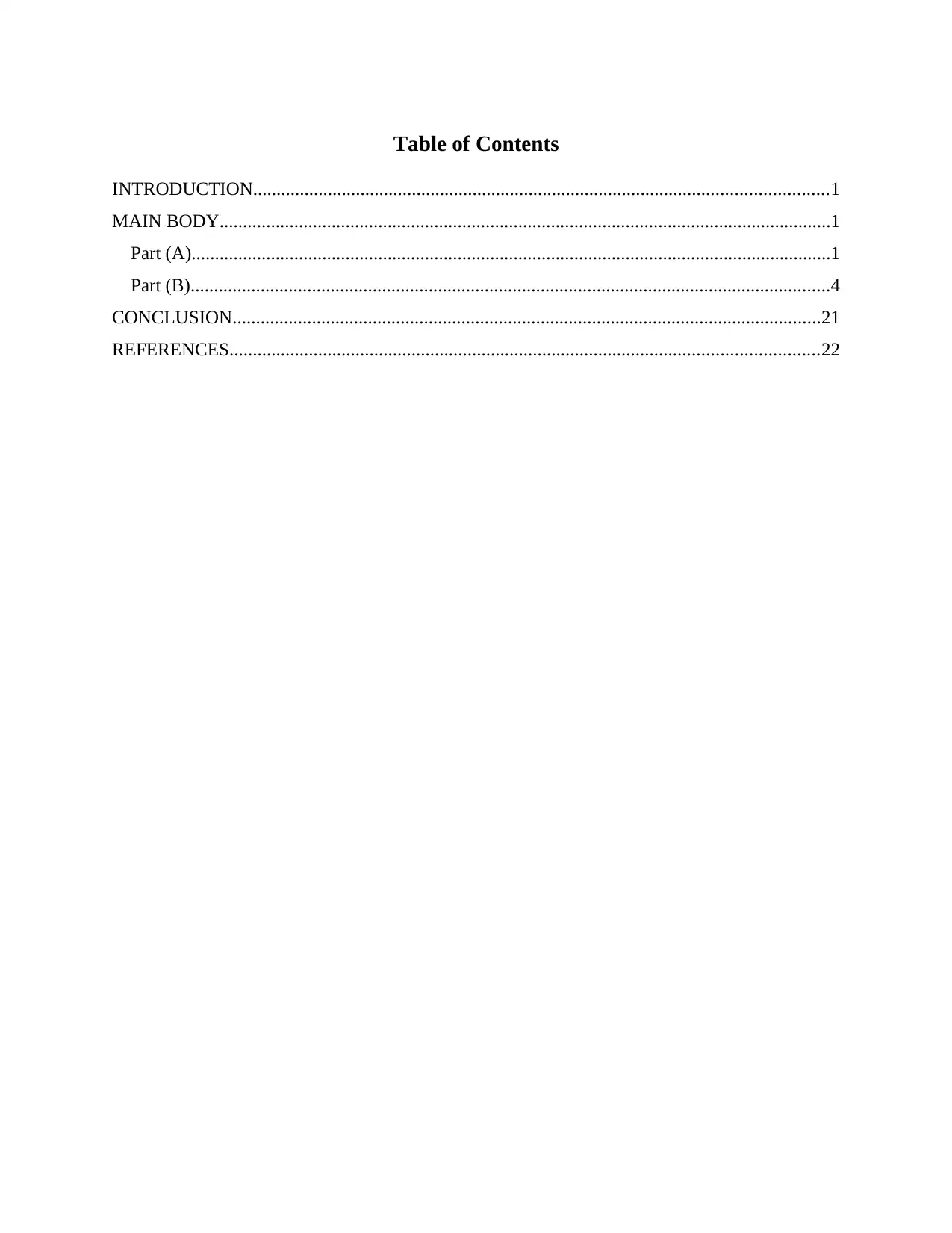
Table of Contents
INTRODUCTION...........................................................................................................................1
MAIN BODY...................................................................................................................................1
Part (A).........................................................................................................................................1
Part (B).........................................................................................................................................4
CONCLUSION..............................................................................................................................21
REFERENCES..............................................................................................................................22
INTRODUCTION...........................................................................................................................1
MAIN BODY...................................................................................................................................1
Part (A).........................................................................................................................................1
Part (B).........................................................................................................................................4
CONCLUSION..............................................................................................................................21
REFERENCES..............................................................................................................................22
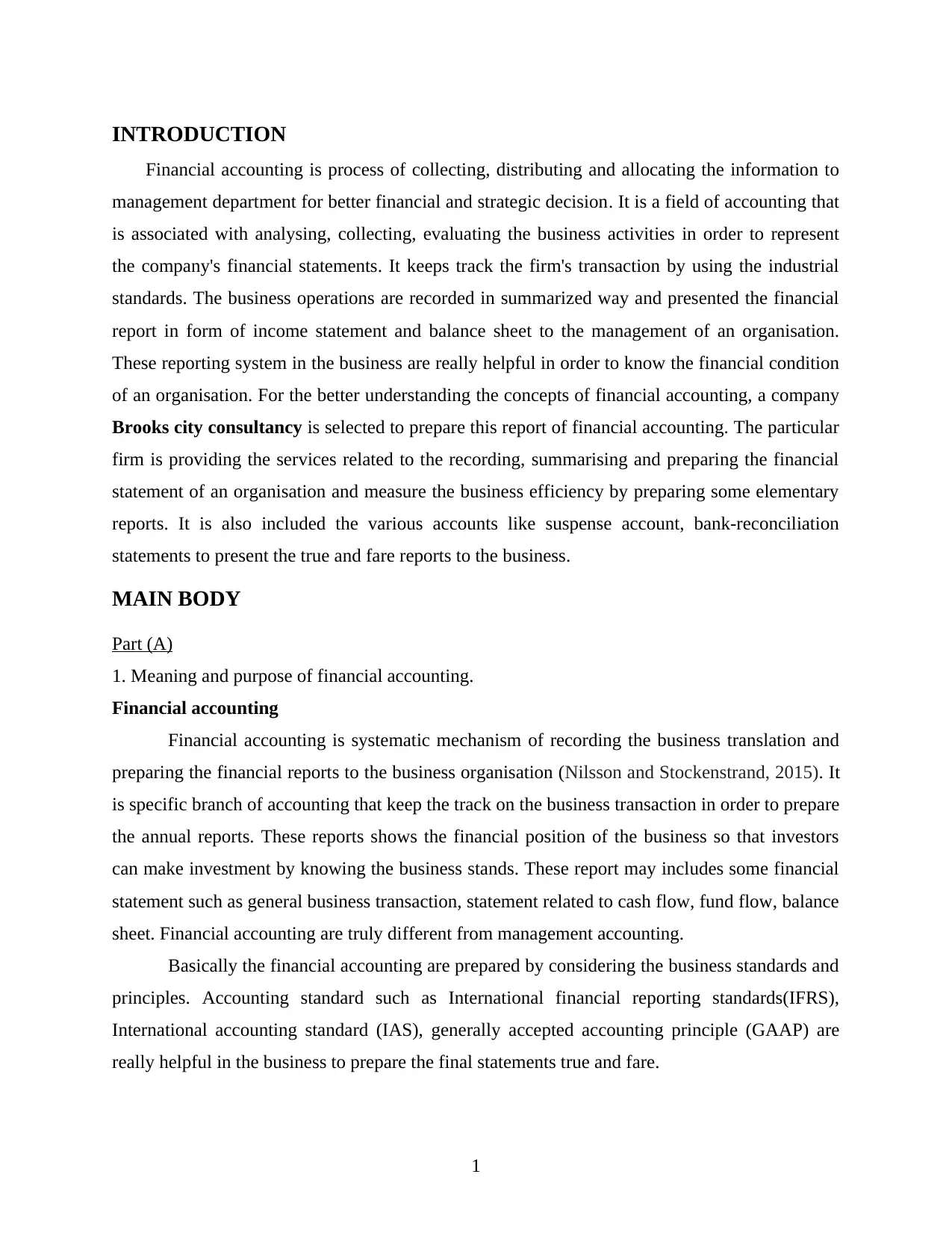
INTRODUCTION
Financial accounting is process of collecting, distributing and allocating the information to
management department for better financial and strategic decision. It is a field of accounting that
is associated with analysing, collecting, evaluating the business activities in order to represent
the company's financial statements. It keeps track the firm's transaction by using the industrial
standards. The business operations are recorded in summarized way and presented the financial
report in form of income statement and balance sheet to the management of an organisation.
These reporting system in the business are really helpful in order to know the financial condition
of an organisation. For the better understanding the concepts of financial accounting, a company
Brooks city consultancy is selected to prepare this report of financial accounting. The particular
firm is providing the services related to the recording, summarising and preparing the financial
statement of an organisation and measure the business efficiency by preparing some elementary
reports. It is also included the various accounts like suspense account, bank-reconciliation
statements to present the true and fare reports to the business.
MAIN BODY
Part (A)
1. Meaning and purpose of financial accounting.
Financial accounting
Financial accounting is systematic mechanism of recording the business translation and
preparing the financial reports to the business organisation (Nilsson and Stockenstrand, 2015). It
is specific branch of accounting that keep the track on the business transaction in order to prepare
the annual reports. These reports shows the financial position of the business so that investors
can make investment by knowing the business stands. These report may includes some financial
statement such as general business transaction, statement related to cash flow, fund flow, balance
sheet. Financial accounting are truly different from management accounting.
Basically the financial accounting are prepared by considering the business standards and
principles. Accounting standard such as International financial reporting standards(IFRS),
International accounting standard (IAS), generally accepted accounting principle (GAAP) are
really helpful in the business to prepare the final statements true and fare.
1
Financial accounting is process of collecting, distributing and allocating the information to
management department for better financial and strategic decision. It is a field of accounting that
is associated with analysing, collecting, evaluating the business activities in order to represent
the company's financial statements. It keeps track the firm's transaction by using the industrial
standards. The business operations are recorded in summarized way and presented the financial
report in form of income statement and balance sheet to the management of an organisation.
These reporting system in the business are really helpful in order to know the financial condition
of an organisation. For the better understanding the concepts of financial accounting, a company
Brooks city consultancy is selected to prepare this report of financial accounting. The particular
firm is providing the services related to the recording, summarising and preparing the financial
statement of an organisation and measure the business efficiency by preparing some elementary
reports. It is also included the various accounts like suspense account, bank-reconciliation
statements to present the true and fare reports to the business.
MAIN BODY
Part (A)
1. Meaning and purpose of financial accounting.
Financial accounting
Financial accounting is systematic mechanism of recording the business translation and
preparing the financial reports to the business organisation (Nilsson and Stockenstrand, 2015). It
is specific branch of accounting that keep the track on the business transaction in order to prepare
the annual reports. These reports shows the financial position of the business so that investors
can make investment by knowing the business stands. These report may includes some financial
statement such as general business transaction, statement related to cash flow, fund flow, balance
sheet. Financial accounting are truly different from management accounting.
Basically the financial accounting are prepared by considering the business standards and
principles. Accounting standard such as International financial reporting standards(IFRS),
International accounting standard (IAS), generally accepted accounting principle (GAAP) are
really helpful in the business to prepare the final statements true and fare.
1
⊘ This is a preview!⊘
Do you want full access?
Subscribe today to unlock all pages.

Trusted by 1+ million students worldwide
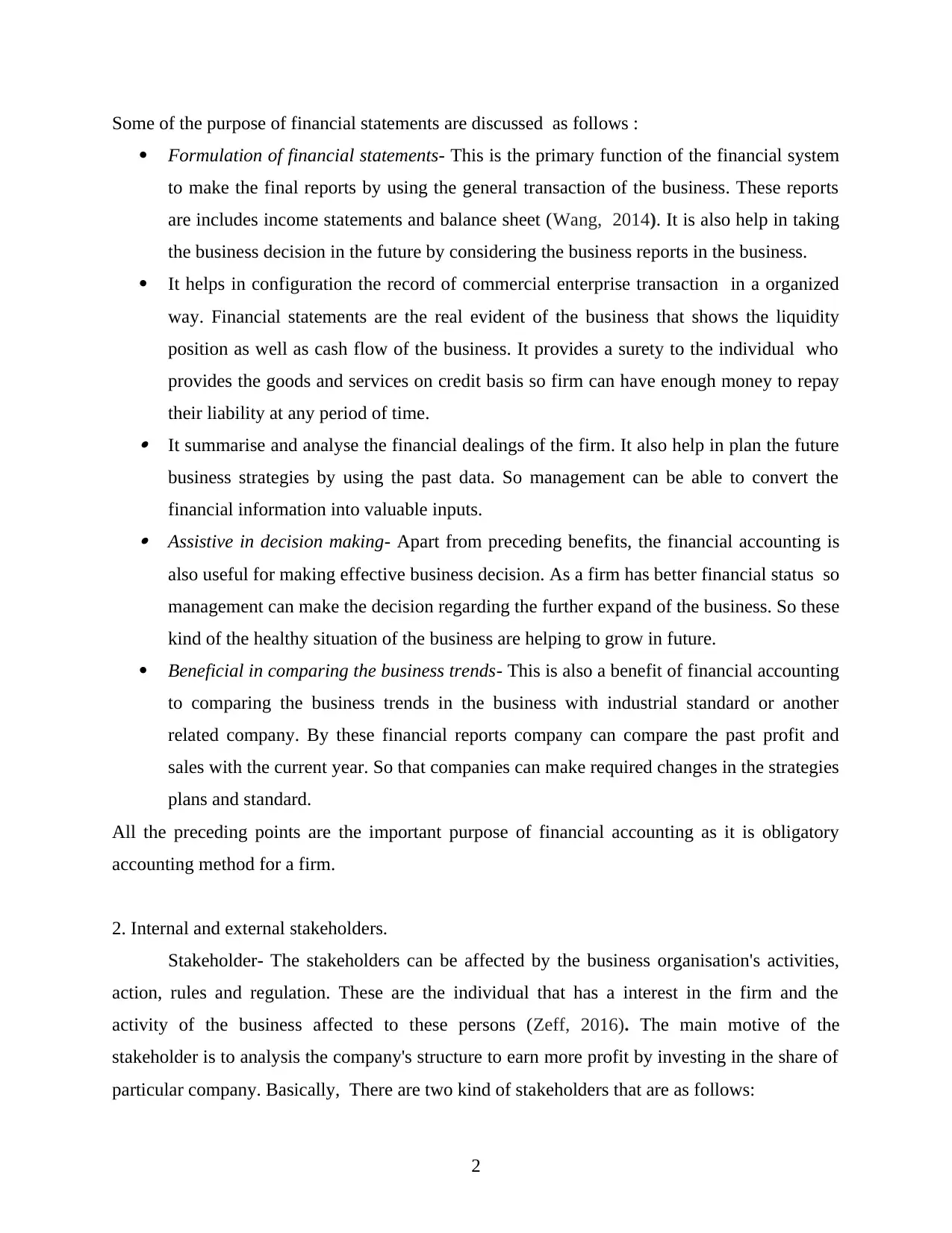
Some of the purpose of financial statements are discussed as follows :
Formulation of financial statements- This is the primary function of the financial system
to make the final reports by using the general transaction of the business. These reports
are includes income statements and balance sheet (Wang, 2014). It is also help in taking
the business decision in the future by considering the business reports in the business.
It helps in configuration the record of commercial enterprise transaction in a organized
way. Financial statements are the real evident of the business that shows the liquidity
position as well as cash flow of the business. It provides a surety to the individual who
provides the goods and services on credit basis so firm can have enough money to repay
their liability at any period of time. It summarise and analyse the financial dealings of the firm. It also help in plan the future
business strategies by using the past data. So management can be able to convert the
financial information into valuable inputs. Assistive in decision making- Apart from preceding benefits, the financial accounting is
also useful for making effective business decision. As a firm has better financial status so
management can make the decision regarding the further expand of the business. So these
kind of the healthy situation of the business are helping to grow in future.
Beneficial in comparing the business trends- This is also a benefit of financial accounting
to comparing the business trends in the business with industrial standard or another
related company. By these financial reports company can compare the past profit and
sales with the current year. So that companies can make required changes in the strategies
plans and standard.
All the preceding points are the important purpose of financial accounting as it is obligatory
accounting method for a firm.
2. Internal and external stakeholders.
Stakeholder- The stakeholders can be affected by the business organisation's activities,
action, rules and regulation. These are the individual that has a interest in the firm and the
activity of the business affected to these persons (Zeff, 2016). The main motive of the
stakeholder is to analysis the company's structure to earn more profit by investing in the share of
particular company. Basically, There are two kind of stakeholders that are as follows:
2
Formulation of financial statements- This is the primary function of the financial system
to make the final reports by using the general transaction of the business. These reports
are includes income statements and balance sheet (Wang, 2014). It is also help in taking
the business decision in the future by considering the business reports in the business.
It helps in configuration the record of commercial enterprise transaction in a organized
way. Financial statements are the real evident of the business that shows the liquidity
position as well as cash flow of the business. It provides a surety to the individual who
provides the goods and services on credit basis so firm can have enough money to repay
their liability at any period of time. It summarise and analyse the financial dealings of the firm. It also help in plan the future
business strategies by using the past data. So management can be able to convert the
financial information into valuable inputs. Assistive in decision making- Apart from preceding benefits, the financial accounting is
also useful for making effective business decision. As a firm has better financial status so
management can make the decision regarding the further expand of the business. So these
kind of the healthy situation of the business are helping to grow in future.
Beneficial in comparing the business trends- This is also a benefit of financial accounting
to comparing the business trends in the business with industrial standard or another
related company. By these financial reports company can compare the past profit and
sales with the current year. So that companies can make required changes in the strategies
plans and standard.
All the preceding points are the important purpose of financial accounting as it is obligatory
accounting method for a firm.
2. Internal and external stakeholders.
Stakeholder- The stakeholders can be affected by the business organisation's activities,
action, rules and regulation. These are the individual that has a interest in the firm and the
activity of the business affected to these persons (Zeff, 2016). The main motive of the
stakeholder is to analysis the company's structure to earn more profit by investing in the share of
particular company. Basically, There are two kind of stakeholders that are as follows:
2
Paraphrase This Document
Need a fresh take? Get an instant paraphrase of this document with our AI Paraphraser
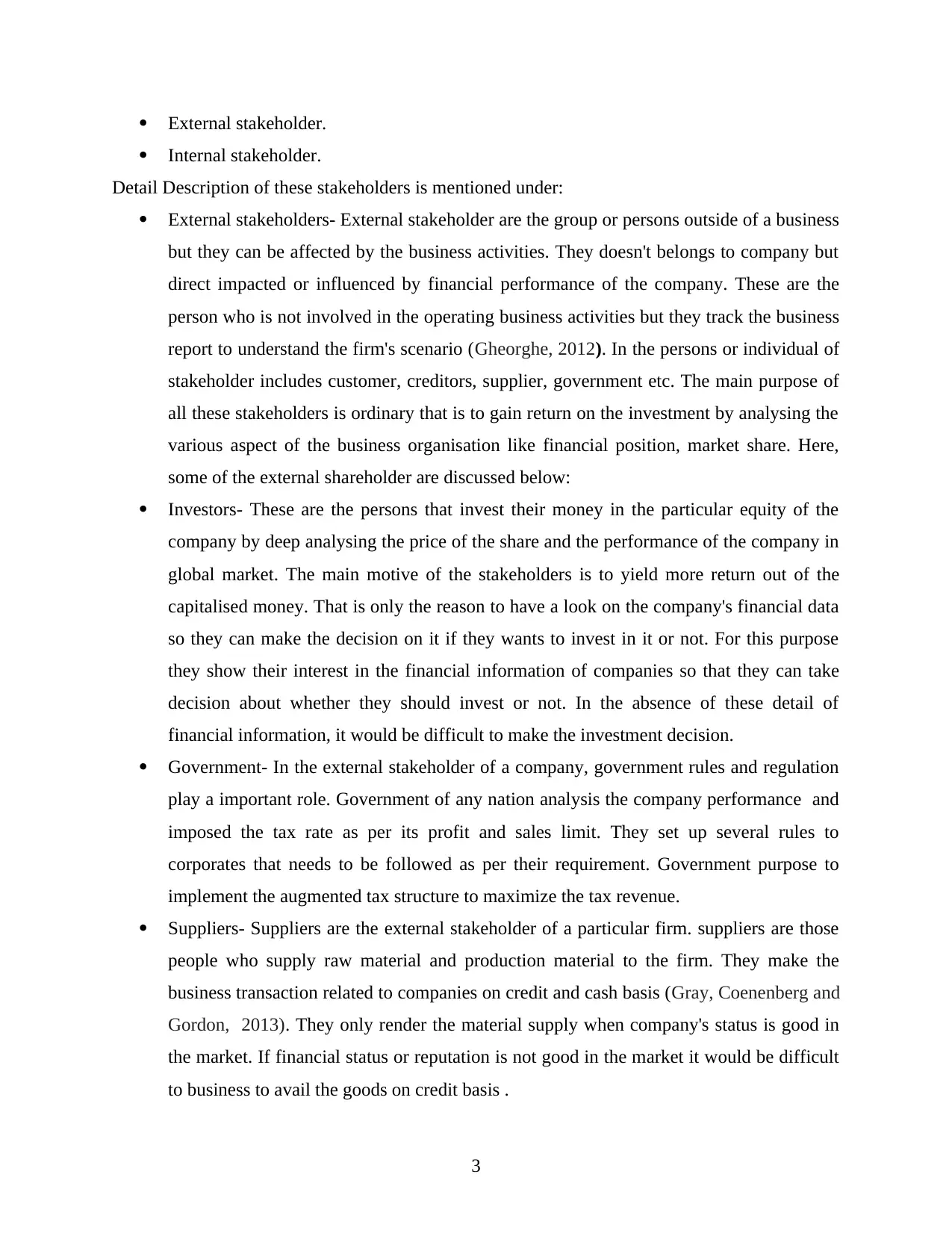
External stakeholder.
Internal stakeholder.
Detail Description of these stakeholders is mentioned under:
External stakeholders- External stakeholder are the group or persons outside of a business
but they can be affected by the business activities. They doesn't belongs to company but
direct impacted or influenced by financial performance of the company. These are the
person who is not involved in the operating business activities but they track the business
report to understand the firm's scenario (Gheorghe, 2012). In the persons or individual of
stakeholder includes customer, creditors, supplier, government etc. The main purpose of
all these stakeholders is ordinary that is to gain return on the investment by analysing the
various aspect of the business organisation like financial position, market share. Here,
some of the external shareholder are discussed below:
Investors- These are the persons that invest their money in the particular equity of the
company by deep analysing the price of the share and the performance of the company in
global market. The main motive of the stakeholders is to yield more return out of the
capitalised money. That is only the reason to have a look on the company's financial data
so they can make the decision on it if they wants to invest in it or not. For this purpose
they show their interest in the financial information of companies so that they can take
decision about whether they should invest or not. In the absence of these detail of
financial information, it would be difficult to make the investment decision.
Government- In the external stakeholder of a company, government rules and regulation
play a important role. Government of any nation analysis the company performance and
imposed the tax rate as per its profit and sales limit. They set up several rules to
corporates that needs to be followed as per their requirement. Government purpose to
implement the augmented tax structure to maximize the tax revenue.
Suppliers- Suppliers are the external stakeholder of a particular firm. suppliers are those
people who supply raw material and production material to the firm. They make the
business transaction related to companies on credit and cash basis (Gray, Coenenberg and
Gordon, 2013). They only render the material supply when company's status is good in
the market. If financial status or reputation is not good in the market it would be difficult
to business to avail the goods on credit basis .
3
Internal stakeholder.
Detail Description of these stakeholders is mentioned under:
External stakeholders- External stakeholder are the group or persons outside of a business
but they can be affected by the business activities. They doesn't belongs to company but
direct impacted or influenced by financial performance of the company. These are the
person who is not involved in the operating business activities but they track the business
report to understand the firm's scenario (Gheorghe, 2012). In the persons or individual of
stakeholder includes customer, creditors, supplier, government etc. The main purpose of
all these stakeholders is ordinary that is to gain return on the investment by analysing the
various aspect of the business organisation like financial position, market share. Here,
some of the external shareholder are discussed below:
Investors- These are the persons that invest their money in the particular equity of the
company by deep analysing the price of the share and the performance of the company in
global market. The main motive of the stakeholders is to yield more return out of the
capitalised money. That is only the reason to have a look on the company's financial data
so they can make the decision on it if they wants to invest in it or not. For this purpose
they show their interest in the financial information of companies so that they can take
decision about whether they should invest or not. In the absence of these detail of
financial information, it would be difficult to make the investment decision.
Government- In the external stakeholder of a company, government rules and regulation
play a important role. Government of any nation analysis the company performance and
imposed the tax rate as per its profit and sales limit. They set up several rules to
corporates that needs to be followed as per their requirement. Government purpose to
implement the augmented tax structure to maximize the tax revenue.
Suppliers- Suppliers are the external stakeholder of a particular firm. suppliers are those
people who supply raw material and production material to the firm. They make the
business transaction related to companies on credit and cash basis (Gray, Coenenberg and
Gordon, 2013). They only render the material supply when company's status is good in
the market. If financial status or reputation is not good in the market it would be difficult
to business to avail the goods on credit basis .
3
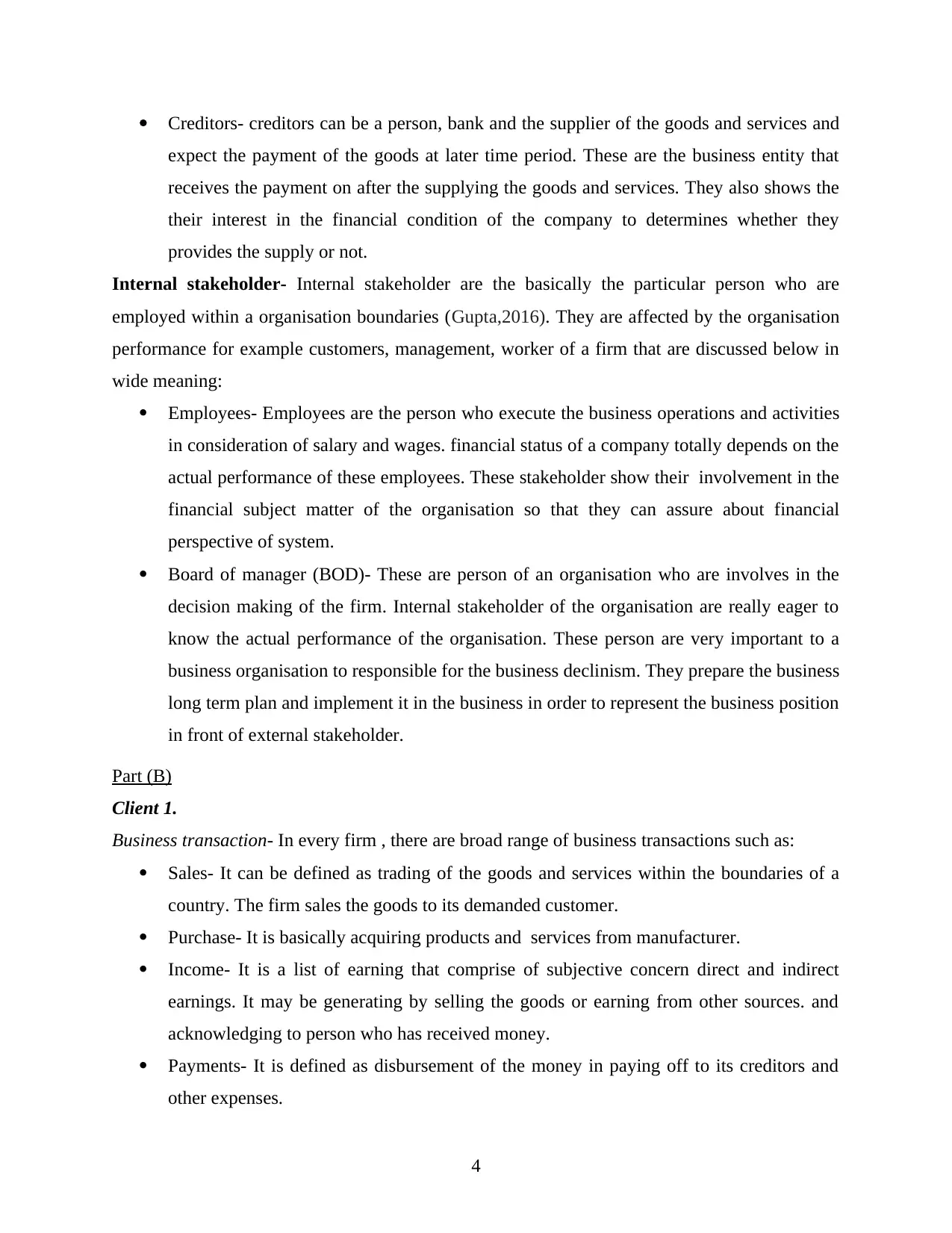
Creditors- creditors can be a person, bank and the supplier of the goods and services and
expect the payment of the goods at later time period. These are the business entity that
receives the payment on after the supplying the goods and services. They also shows the
their interest in the financial condition of the company to determines whether they
provides the supply or not.
Internal stakeholder- Internal stakeholder are the basically the particular person who are
employed within a organisation boundaries (Gupta,2016). They are affected by the organisation
performance for example customers, management, worker of a firm that are discussed below in
wide meaning:
Employees- Employees are the person who execute the business operations and activities
in consideration of salary and wages. financial status of a company totally depends on the
actual performance of these employees. These stakeholder show their involvement in the
financial subject matter of the organisation so that they can assure about financial
perspective of system.
Board of manager (BOD)- These are person of an organisation who are involves in the
decision making of the firm. Internal stakeholder of the organisation are really eager to
know the actual performance of the organisation. These person are very important to a
business organisation to responsible for the business declinism. They prepare the business
long term plan and implement it in the business in order to represent the business position
in front of external stakeholder.
Part (B)
Client 1.
Business transaction- In every firm , there are broad range of business transactions such as:
Sales- It can be defined as trading of the goods and services within the boundaries of a
country. The firm sales the goods to its demanded customer.
Purchase- It is basically acquiring products and services from manufacturer.
Income- It is a list of earning that comprise of subjective concern direct and indirect
earnings. It may be generating by selling the goods or earning from other sources. and
acknowledging to person who has received money.
Payments- It is defined as disbursement of the money in paying off to its creditors and
other expenses.
4
expect the payment of the goods at later time period. These are the business entity that
receives the payment on after the supplying the goods and services. They also shows the
their interest in the financial condition of the company to determines whether they
provides the supply or not.
Internal stakeholder- Internal stakeholder are the basically the particular person who are
employed within a organisation boundaries (Gupta,2016). They are affected by the organisation
performance for example customers, management, worker of a firm that are discussed below in
wide meaning:
Employees- Employees are the person who execute the business operations and activities
in consideration of salary and wages. financial status of a company totally depends on the
actual performance of these employees. These stakeholder show their involvement in the
financial subject matter of the organisation so that they can assure about financial
perspective of system.
Board of manager (BOD)- These are person of an organisation who are involves in the
decision making of the firm. Internal stakeholder of the organisation are really eager to
know the actual performance of the organisation. These person are very important to a
business organisation to responsible for the business declinism. They prepare the business
long term plan and implement it in the business in order to represent the business position
in front of external stakeholder.
Part (B)
Client 1.
Business transaction- In every firm , there are broad range of business transactions such as:
Sales- It can be defined as trading of the goods and services within the boundaries of a
country. The firm sales the goods to its demanded customer.
Purchase- It is basically acquiring products and services from manufacturer.
Income- It is a list of earning that comprise of subjective concern direct and indirect
earnings. It may be generating by selling the goods or earning from other sources. and
acknowledging to person who has received money.
Payments- It is defined as disbursement of the money in paying off to its creditors and
other expenses.
4
⊘ This is a preview!⊘
Do you want full access?
Subscribe today to unlock all pages.

Trusted by 1+ million students worldwide
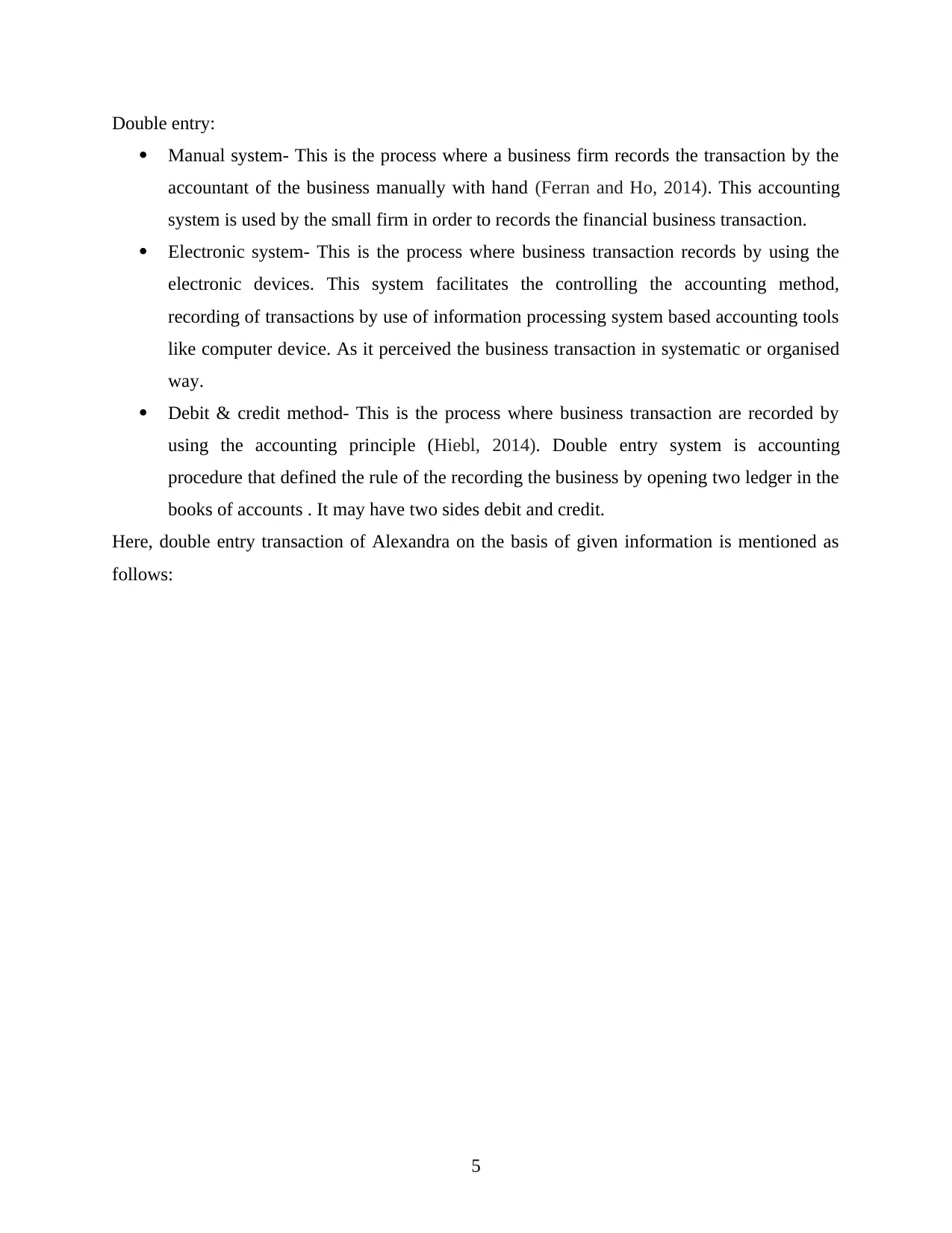
Double entry:
Manual system- This is the process where a business firm records the transaction by the
accountant of the business manually with hand (Ferran and Ho, 2014). This accounting
system is used by the small firm in order to records the financial business transaction.
Electronic system- This is the process where business transaction records by using the
electronic devices. This system facilitates the controlling the accounting method,
recording of transactions by use of information processing system based accounting tools
like computer device. As it perceived the business transaction in systematic or organised
way.
Debit & credit method- This is the process where business transaction are recorded by
using the accounting principle (Hiebl, 2014). Double entry system is accounting
procedure that defined the rule of the recording the business by opening two ledger in the
books of accounts . It may have two sides debit and credit.
Here, double entry transaction of Alexandra on the basis of given information is mentioned as
follows:
5
Manual system- This is the process where a business firm records the transaction by the
accountant of the business manually with hand (Ferran and Ho, 2014). This accounting
system is used by the small firm in order to records the financial business transaction.
Electronic system- This is the process where business transaction records by using the
electronic devices. This system facilitates the controlling the accounting method,
recording of transactions by use of information processing system based accounting tools
like computer device. As it perceived the business transaction in systematic or organised
way.
Debit & credit method- This is the process where business transaction are recorded by
using the accounting principle (Hiebl, 2014). Double entry system is accounting
procedure that defined the rule of the recording the business by opening two ledger in the
books of accounts . It may have two sides debit and credit.
Here, double entry transaction of Alexandra on the basis of given information is mentioned as
follows:
5
Paraphrase This Document
Need a fresh take? Get an instant paraphrase of this document with our AI Paraphraser
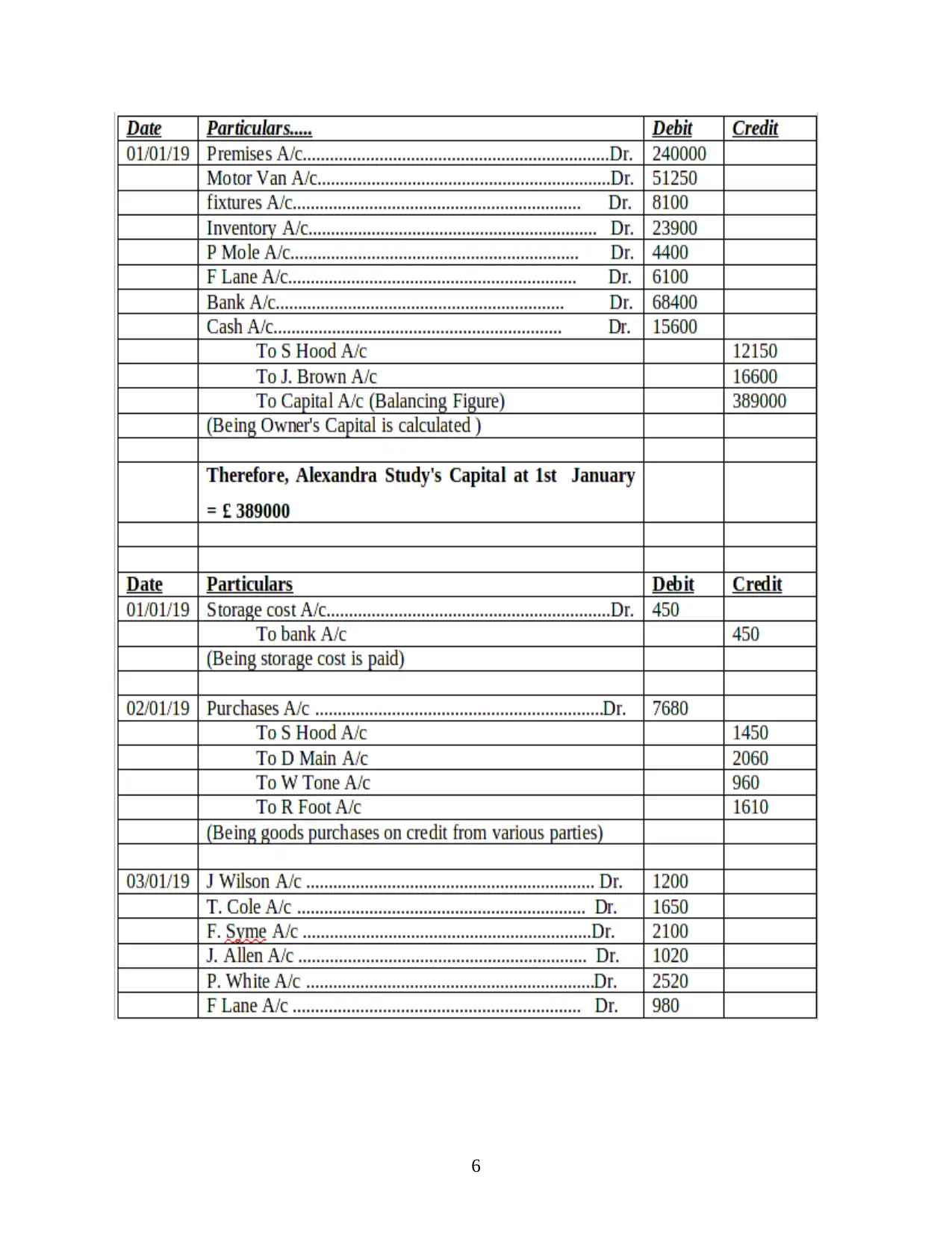
6
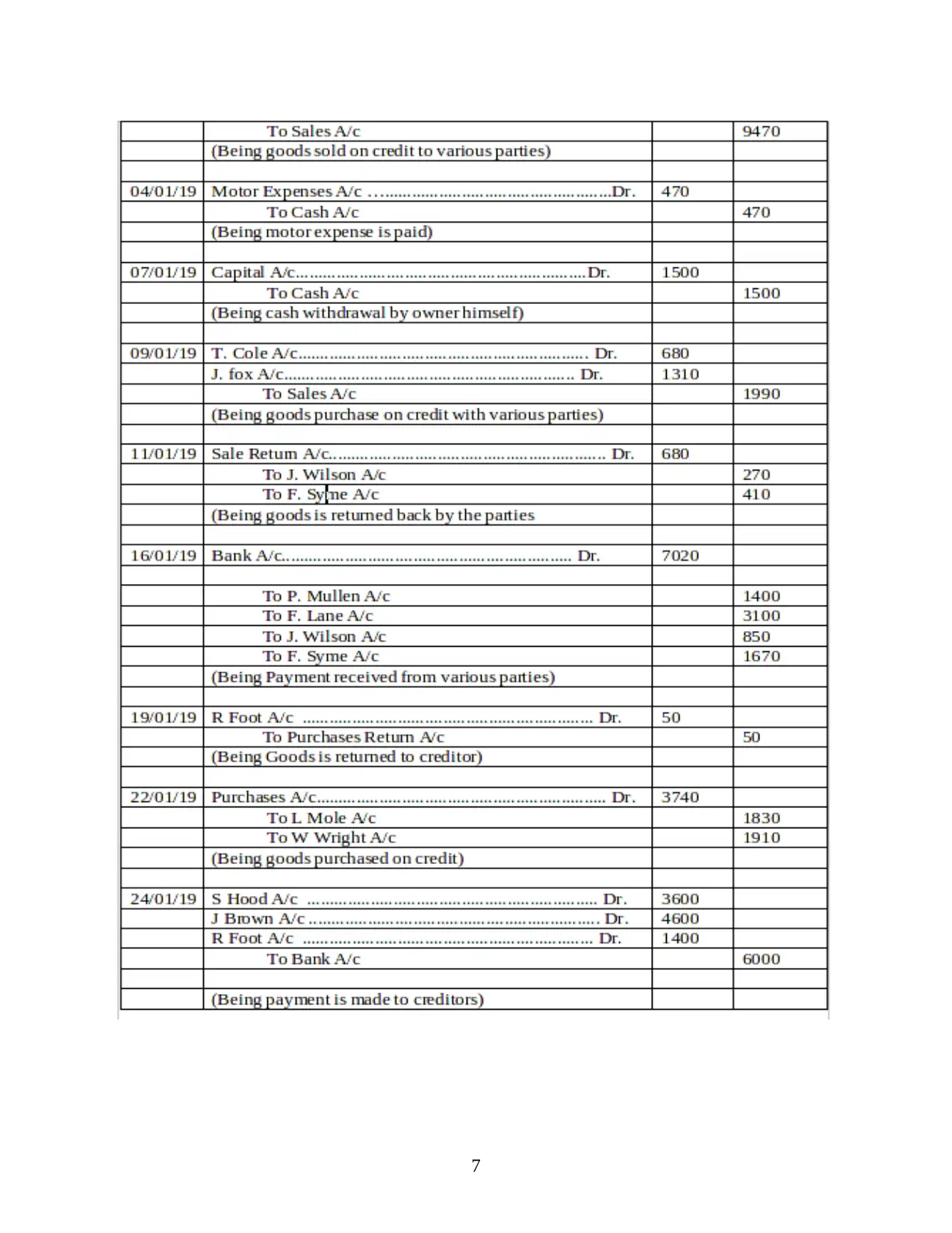
7
⊘ This is a preview!⊘
Do you want full access?
Subscribe today to unlock all pages.

Trusted by 1+ million students worldwide
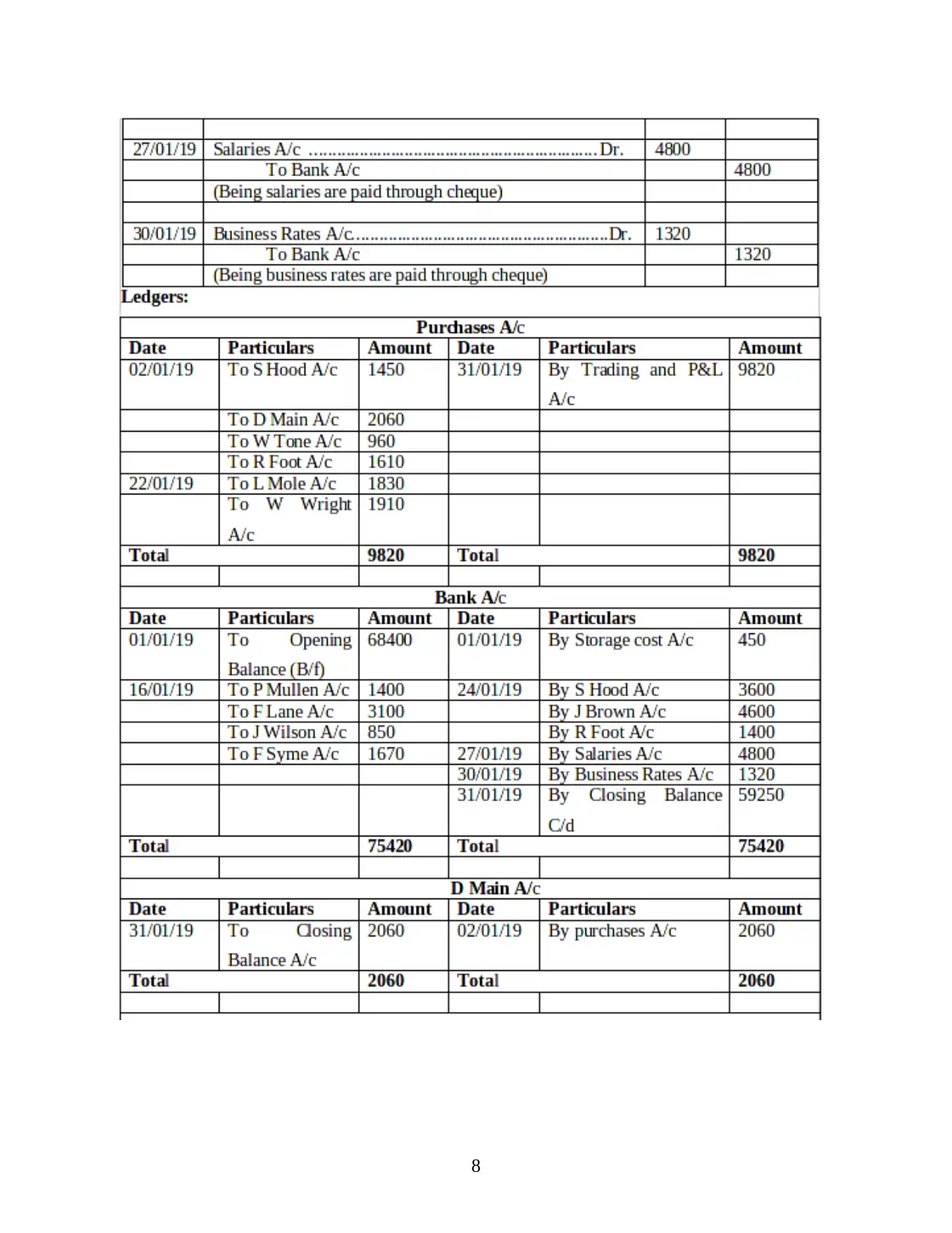
8
Paraphrase This Document
Need a fresh take? Get an instant paraphrase of this document with our AI Paraphraser

9
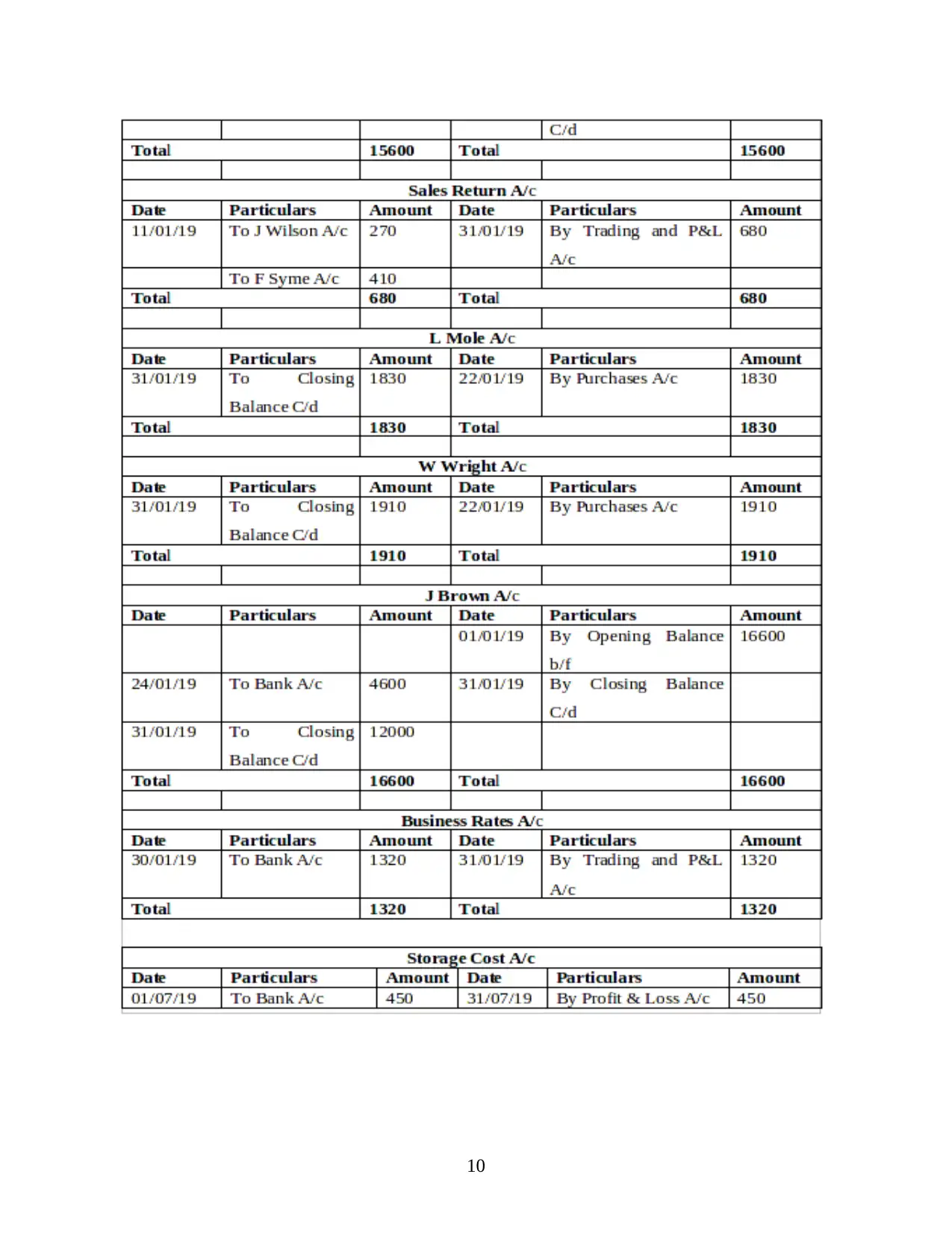
10
⊘ This is a preview!⊘
Do you want full access?
Subscribe today to unlock all pages.

Trusted by 1+ million students worldwide
1 out of 28
Related Documents
Your All-in-One AI-Powered Toolkit for Academic Success.
+13062052269
info@desklib.com
Available 24*7 on WhatsApp / Email
![[object Object]](/_next/static/media/star-bottom.7253800d.svg)
Unlock your academic potential
Copyright © 2020–2025 A2Z Services. All Rights Reserved. Developed and managed by ZUCOL.





